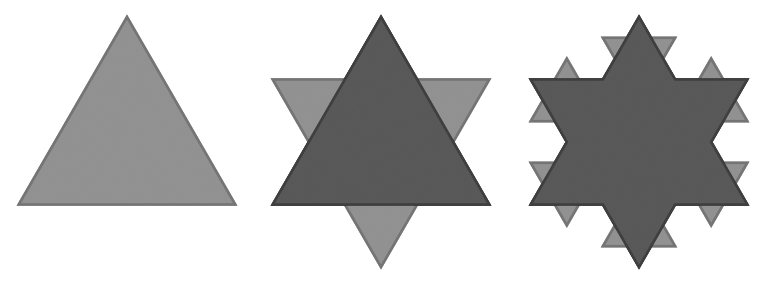Tools to calculate the area and perimeter of the Koch flake (or Koch curve), the curve representing a fractal snowflake from Koch.
Koch Flake - dCode
Tag(s) : Geometry
dCode is free and its tools are a valuable help in games, maths, geocaching, puzzles and problems to solve every day!
A suggestion ? a feedback ? a bug ? an idea ? Write to dCode!
Koch Flake
Area Calculator
Perimeter Calculator
Answers to Questions (FAQ)
What is Koch snowflake? (Definition)
The Koch snowflake is a fractal curve obtained by starting with an equilateral triangle and recursively adding equilateral triangles to the center of each side of the initial triangle. The resulting pattern resembles a snowflake and exhibits self-similarity at different scales. It was first described by the Swedish mathematician Helge von Koch in 1904.
How to draw a Koch flake?
To draw the Koch snowflake, follow these steps/algorithm:
1 - Draw an equilateral triangle (made up of 3 equal segments)
2 - Divide each segment into three equal sub-segments
3 - Construct an equilateral triangle with the central sub-segment as its base and pointing outwards.
4 - Delete the central sub-segment
5 - Repeat steps 2 to 4 for each of the segments of the new figure obtained
Mathematically, the final drawing is called the Koch curve, and its base is a Cantor set.
How to calculate the Koch Flake Perimeter?
The perimeter of the Koch snowflake increases with each iteration. For an initial triangle with side length $ L $, the general formula for the perimeter after $ n $ iterations is: $$ 3 L \left( \frac{4}{3} \right)^n $$
Indeed, the initial triangle has an initial perimeter of $ 3L $. At each iteration, any segment composed of 3 sub-segments is replaced by a broken line of 4 segments (all of the same size). The number of segments is therefore multiplied by $ 4/3 $ at each step. > After 2 iterations, a line of initial length $ L $ is now $ L \times \frac{4}{3} \times \frac{4}{3} = L \times \frac{16}{9} \approx 1.778L $
When $ n $ tends to infinity, then $$ \lim\limits_{n \to +\infty} 3 L \left( \frac{4}{3} \right)^n = +\infty $$
The total length of the fractal curve is therefore theoretically infinite.
How to calculate the area of the Koch flake?
With an initial triangle of side length $ L $, the formula for the total area of the snowflake after $ n $ iterations is:
$$ A_n = \frac{\sqrt{3}}{20} L^2 \left( 8-3 \left( \frac{4}{9} \right) ^n \right) $$
As $ n $ approaches infinity, the area of the snowflake converges to a finite value:
$$ A = \lim\limits_{n \to +\infty} A_n = \frac{ 2 \sqrt{3} }{5} L^2 $$
This area is exactly $ 8/5 $ of the area of the initial triangle (which was $ \frac{\sqrt{3}}{4} L^2 $)
What is the fractal dimension of the Koch snowflake?
The fractal dimension of the Koch snowflake, denoted $ D $, is calculated using the fractal dimension formula: $$ D = \frac{ \ln(3) } { \ln(4) } \approx 1.2619 $$
The Koch snowflake can be seen as a fractal attractor.
How many segments make up the Koch snowflake?
The number of segments composing the snowflake after $ n $ iterations is given by the formula: $$ 3 \times 4^n $$
Each segment decreases in size at each iteration according to the formula $ L_{n} = \frac{L}{3^n} $
How to physically construct a Koch snowflake?
It is impossible to construct a Koch snowflake in the real world perfectly because it would require an infinite number of subdivisions.
However, it is possible to approximate the final curve with a large number of iterations, making the result visually very close to the theoretical snowflake.
Source code
dCode retains ownership of the "Koch Flake" source code. Any algorithm for the "Koch Flake" algorithm, applet or snippet or script (converter, solver, encryption / decryption, encoding / decoding, ciphering / deciphering, breaker, translator), or any "Koch Flake" functions (calculate, convert, solve, decrypt / encrypt, decipher / cipher, decode / encode, translate) written in any informatic language (Python, Java, PHP, C#, Javascript, Matlab, etc.) or any database download or API access for "Koch Flake" or any other element are not public (except explicit open source licence). Same with the download for offline use on PC, mobile, tablet, iPhone or Android app.
Reminder: dCode is an educational and teaching resource, accessible online for free and for everyone.
Cite dCode
The content of the page "Koch Flake" and its results may be freely copied and reused, including for commercial purposes, provided that dCode.fr is cited as the source (Creative Commons CC-BY free distribution license).
Exporting the results is free and can be done simply by clicking on the export icons ⤓ (.csv or .txt format) or ⧉ (copy and paste).
To cite dCode.fr on another website, use the link:
In a scientific article or book, the recommended bibliographic citation is: Koch Flake on dCode.fr [online website], retrieved on 2025-10-21,
- Area Calculator
- Perimeter Calculator
- What is Koch snowflake? (Definition)
- How to draw a Koch flake?
- How to calculate the Koch Flake Perimeter?
- How to calculate the area of the Koch flake?
- What is the fractal dimension of the Koch snowflake?
- How many segments make up the Koch snowflake?
- How to physically construct a Koch snowflake?

